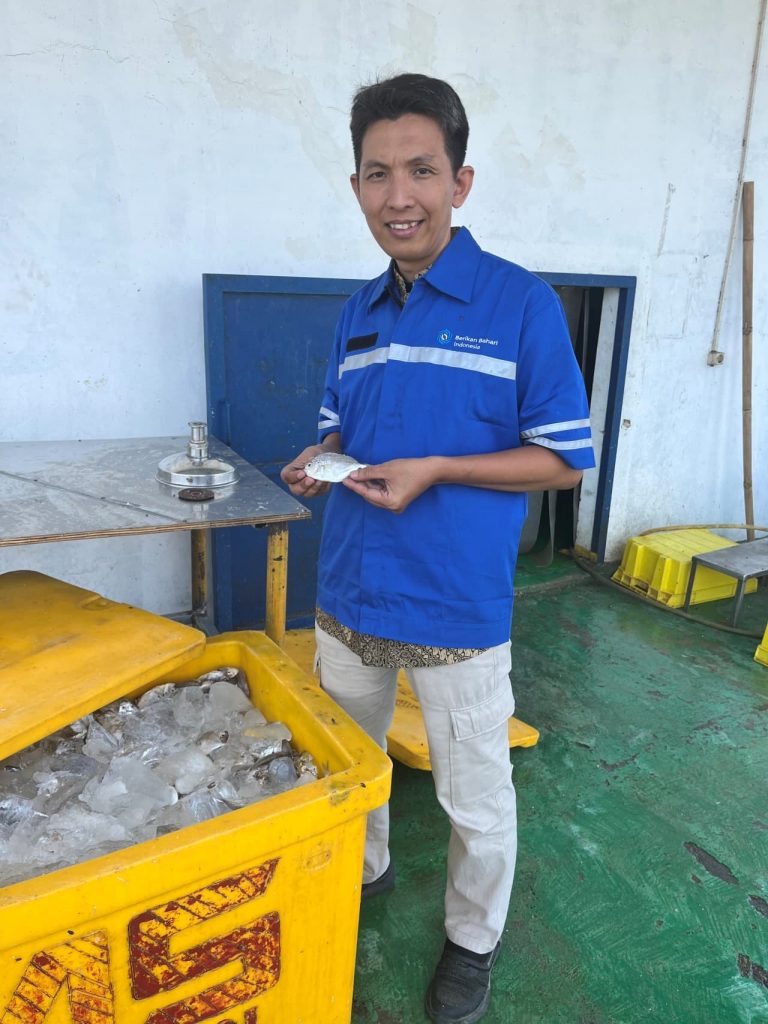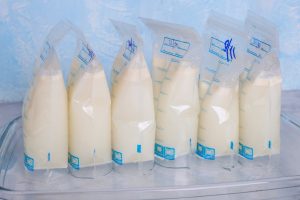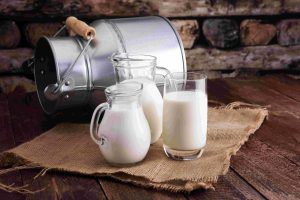INDRAMAYU, Indonesia—Grocery aisles are filled with a range of “milk” options, from almond to soy and goat to oat. But have you heard of fish milk?
Some in Indonesia want to make it a thing.
The archipelago nation is fish-rich but cow-poor. Last year, a nonprofit foundation began milking the fish, so to speak. The process begins in the coastal town of Indramayu where twice a day fishermen deliver their catch of ponyfish and other coastal fish to a factory. There, the creatures are deboned, broken down using a chemical process called hydrolysis, dried and reduced to a white protein-rich powder.

Iced fish for processing at the Indramayu factory. Photo: Jon Emont/WSJ

Mafatihul Khoiri, factory manager at the processing plant. Photo: Jon Emont/WSJ
The powder is then trucked to a separate facility where it is mixed with strawberry or chocolate flavoring, and sugar, and boxed for distribution.
Mix the concoction with water and ta-da: fish milk.
“It just tastes like normal milk, at least to me,” said Mafatihul Khoiri, who manages production for the foundation, Berikan Protein Initiative.
The product has generated some consternation online. After recent local news coverage of fish milk as a potential option for school meal programs, one Tiktoker asked: “Do fish breast-feed?”
While fish milk has limited reach so far—available online and distributed by a nutrition-focused community group—a senior fisheries official believes it is an idea whose time has come. Budi Sulistyo’s ambition is represented on a map of Indonesia covered in dots of two colors. Blue shows potential factory locations where the powder can be made; orange marks facilities where it can be flavored, sweetened and packed.
With state support, Sulistyo says the industry could employ 200,000 people, with a production capacity of 500,000 tons annually, worth an estimated $4.5 billion. He personally favors the strawberry flavor though he says the chocolate hits better in the evening.
“We’re very optimistic,” he said.
Not everyone is convinced. Health Minister Budi Gunadi Sadikin says that while Indonesians need to boost their nutrition, he prefers the variety of milk that comes from cattle.
“We can grow cows,” he said. “Or we can import the milk from Australia. Or we can buy an Australian cow company or milk company.”
“There are many, many, many options to do before we are milking the fish,” he said.
Powder derived from fish collagen—a protein found in fish skin and scales—is sold in the U.S. and elsewhere, with companies promising healthier hair and youthful skin. The powder can be mixed into milk shakes and many sellers tout a neutral taste, though online reviewers sometimes complain of fishy odors.
But the Indonesian product is different because the powder comes from the flesh of the fish. That way drinkers get all nine essential amino acids, the Berikan Protein Initiative said.
Some consumers say it’s an acquired taste. When Diah Rodiah first sampled fish milk, she found the odor offensive. The 27-year-old was introduced to the drink through Kitabisa, a nonprofit organization that delivers high-protein meals to expectant mothers. She started out with the chocolate-flavored option, which fish milk drinkers consider fishier-smelling than the strawberry one.
“I had to force it down,” said Rodiah, who also didn’t do herself any favors when she mixed the fish powder with hot water, which she thought brought out the smell even more.
She wasn’t deterred, though. She traded hot water for ice cubes, and found that made the drink palatable. “It was good,” she said.
Rosaedah, 23, who uses only one name, decided to play around with the flavors. She turned her fish milk into a pudding, mixing it with a jellylike substance derived from seaweed called agar-agar. She made layers with the chocolate fish milk and the strawberry fish milk.
“Delicious!” she pronounced. “I’ve made it three times.”
Indonesians aren’t the only ones trying to work out the riddles of fish milk. The European Union has funded scientists at Norce, a research institute in Norway, to study how to remove the chemical that’s the main cause of the fishy smell in certain fish protein powders. Last year, the Norce team, working with colleagues in Spain, published a paper demonstrating a way to banish the chemical. The team hopes their breakthrough will open the door to greater fish powder consumption, like in protein shakes for athletes and protein-rich meals for the elderly.
Could these learnings be brought to Indonesia? Rasmus Ree, a Norce researcher, says he isn’t sure, because his team did their studies on salmon and not ponyfish. Still, he thinks the Indonesians are on the right track and fish drinks have great potential.
“This is something that would be useful, and hopefully economically viable,” he said.
The origins of Indonesian fish milk trace back to 2017, when government researchers began exploring ways to derive protein from fish using a chemical process known as enzymatic hydrolysis. Berikan Protein Initiative piggybacked on the research, setting up a factory in 2021 and launching fish milk last year.
Fish milk proponents say it maximizes resources by allowing people to consume protein from the sorts of smaller fish that Indonesians often avoid eating. Some nutrition experts, however, argue that the last thing Indonesians need is more ultra-processed food mixed with sugar and artificial flavoring.
Maqbulatin Nuha, Berikan Protein Initiative’s chief executive, says the foundation is committed to a healthy product. It has cut the amount of sugar in fish milk from 13 grams in prototype versions to 4.7 grams.
But less sugar means there’s less to distract taste buds from the fishiness. In reducing the sugar content, the group also cut back on the amount of fish protein, reducing the amount per serving from 9 grams to 5 grams.
“We’re more focused on market acceptance first,” said Nuha, whose organization also makes fish protein-infused cookies.
—Betsy McKay contributed to this article.
Write to Jon Emont at jonathan.emont@wsj.com






